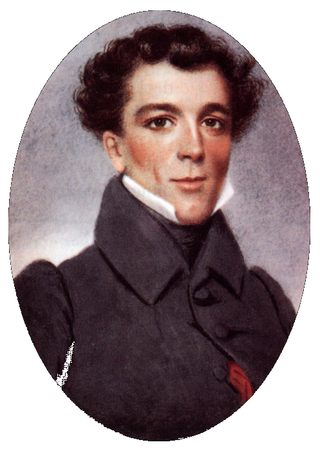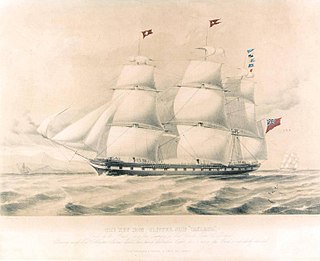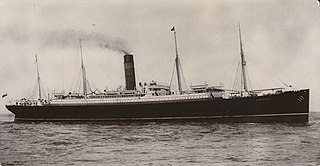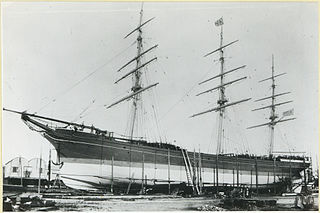
Empress of Ireland was a British-built ocean liner that sank near the mouth of the Saint Lawrence River in Canada following a collision in thick fog with the Norwegian collier Storstad in the early hours of 29 May 1914. Although the ship was equipped with watertight compartments and, in the aftermath of the Titanic disaster two years earlier, carried more than enough lifeboats for all aboard, she foundered in only 14 minutes. Of the 1,477 people on board, 1,012 died, making it the worst peacetime maritime disaster in Canadian history.

Captain Robert Bennet Forbes, was an American sea captain, China merchant and ship owner. He was active in ship construction, maritime safety, the opium trade, and charitable activities, including food aid to Ireland, which became known as America's first major disaster relief effort.

RMS Tayleur was a full-rigged iron clipper ship chartered by the White Star Line. She was large, fast and technically advanced. She ran aground off Lambay Island and sank, on her maiden voyage, in 1854. Of more than 650 aboard, only 280 survived. She has been described as "the first Titanic".

Cataraqui was a British barque which sank off the south-west coast of King Island in Bass Strait on 4 August 1845. The sinking was Australia's worst ever maritime civil disaster incident, claiming the lives of 400 people.

SS Republic was a sidewheel steamship, originally named SS Tennessee, lost in a hurricane off the coast of Georgia in October 1865, en route to New Orleans.

Peter Iredale was a four-masted steel barque that ran ashore October 25, 1906, on the Oregon coast en route to the Columbia River. She was abandoned on Clatsop Spit near Fort Stevens in Warrenton about four miles (6 km) south of the Columbia River channel. Wreckage is still visible, making it a popular tourist attraction as one of the most accessible shipwrecks of the Graveyard of the Pacific.

Jeanie Johnston is a replica of a three masted barque that was originally built in Quebec, Canada, in 1847 by the Scottish-born shipbuilder John Munn. The replica Jeanie Johnston performs a number of functions: an ocean-going sail training vessel at sea and in port converts into a living history museum on 19th century emigration and, in the evenings, is used as a corporate event venue.

Carpathia was a Cunard Line transatlantic passenger steamship built by Swan Hunter & Wigham Richardson in their shipyard in Wallsend, England.
The Kingstown lifeboat disaster occurred on Christmas Eve 1895 off Kingstown, Ireland, when the Kingstown lifeboat was capsized while attempting to rescue the crew of the stricken SS Palme. The crew of fifteen were lost. The event is commemorated annually at Dún Laoghaire Harbour.
The Eleanor Lancaster was a 3-masted barque built at Maryport in 1839. Launched in 1840, and initially registered in Liverpool, it was operated by David Laidman (named after his wife, Eleanor Ann Hannah née Lancaster, with Captain P.Cowley as captain. In 1845, the ship was re-registered in London and was operated by Soutter & Co, with Captain Francis Lodge in command.
The Dunbrody was a three-masted barque built in Quebec in 1845 by Thomas Hamilton Oliver for the Graves family, merchants from New Ross in Wexford.

Kapunda was a British emigrant ship which sank on 20 January 1887 after colliding with the barque Ada Melmoure in the Atlantic Ocean off the coast of Brazil. She was an iron-hulled ship of 1,095 tons, owned by Frinder, Anderson, and Company
Lady of the Lake was an Aberdeen-built brig that sank off the coast of Newfoundland in May 1833, with the loss of up to 265 passengers and crew. Only fifteen passengers and crew survived
Looshtauk was an Irish emigrant ship, captained by John M. Thain, sailing from the Port of Liverpool to the Port of Quebec on April 17, 1847. 462 passengers boarded at Liverpool. Typhus was caught by two male passengers in Liverpool and broke out during the crossing. Scarlet fever also erupted.

SS Sirio was an Italian passenger steamer that was wrecked off the eastern Spanish coast on 4 August 1906, causing the deaths of at least two hundred Italian and Spanish emigrants bound for Brazil, Uruguay, and Argentina. The wreck had a profound effect on communities in northern Italy and was remembered in popular songs of the era. It was the second worst peacetime maritime disaster in Italian history, only surpassed by the sinking of the Principessa Mafalda nineteen years later.
Several ships have been named Hannah:
The Exmouth was a brig built in 1818. She was classed as a snow in Lloyd's Register of 1845. She worked as a whaler in the British northern whale fishery prior to her life as an emigrant ship sailing between Londonderry and Quebec. She was wrecked against the south side of the Isle of Islay in 1847 during a storm. Two hundred and forty-one people lost their lives; three crewmen survived.

Caleb Grimshaw was a sailing vessel built in 1848 for the Atlantic packet trade. The ship caught fire and sank in 1849, with the death of 90-101 people.










